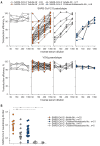Preexisting and de novo humoral immunity to SARS-CoV-2 in humans
- PMID: 33159009
- PMCID: PMC7857411
- DOI: 10.1126/science.abe1107
Preexisting and de novo humoral immunity to SARS-CoV-2 in humans
Abstract
Zoonotic introduction of novel coronaviruses may encounter preexisting immunity in humans. Using diverse assays for antibodies recognizing SARS-CoV-2 proteins, we detected preexisting humoral immunity. SARS-CoV-2 spike glycoprotein (S)-reactive antibodies were detectable using a flow cytometry-based method in SARS-CoV-2-uninfected individuals and were particularly prevalent in children and adolescents. They were predominantly of the immunoglobulin G (IgG) class and targeted the S2 subunit. By contrast, SARS-CoV-2 infection induced higher titers of SARS-CoV-2 S-reactive IgG antibodies targeting both the S1 and S2 subunits, and concomitant IgM and IgA antibodies, lasting throughout the observation period. SARS-CoV-2-uninfected donor sera exhibited specific neutralizing activity against SARS-CoV-2 and SARS-CoV-2 S pseudotypes. Distinguishing preexisting and de novo immunity will be critical for our understanding of susceptibility to and the natural course of SARS-CoV-2 infection.
Copyright © 2020 The Authors, some rights reserved; exclusive licensee American Association for the Advancement of Science. No claim to original U.S. Government Works.
Figures




Comment in
-
Remembering seasonal coronaviruses.Science. 2020 Dec 11;370(6522):1272-1273. doi: 10.1126/science.abf4860. Science. 2020. PMID: 33303605 No abstract available.
-
Do childhood colds help the body respond to COVID?Nature. 2021 Nov;599(7886):540-541. doi: 10.1038/d41586-021-03087-0. Nature. 2021. PMID: 34795432 No abstract available.
Similar articles
-
Profiling Antibody Response Patterns in COVID-19: Spike S1-Reactive IgA Signature in the Evolution of SARS-CoV-2 Infection.Front Immunol. 2021 Nov 3;12:772239. doi: 10.3389/fimmu.2021.772239. eCollection 2021. Front Immunol. 2021. PMID: 34804064 Free PMC article.
-
Titers of IgG and IgA against SARS-CoV-2 proteins and their association with symptoms in mild COVID-19 infection.Sci Rep. 2024 Jun 3;14(1):12725. doi: 10.1038/s41598-024-59634-y. Sci Rep. 2024. PMID: 38830902 Free PMC article.
-
Detection of Serum Cross-Reactive Antibodies and Memory Response to SARS-CoV-2 in Prepandemic and Post-COVID-19 Convalescent Samples.J Infect Dis. 2021 Oct 28;224(8):1305-1315. doi: 10.1093/infdis/jiab333. J Infect Dis. 2021. PMID: 34161567 Free PMC article.
-
Understanding neutralising antibodies against SARS-CoV-2 and their implications in clinical practice.Mil Med Res. 2021 Aug 31;8(1):47. doi: 10.1186/s40779-021-00342-3. Mil Med Res. 2021. PMID: 34465396 Free PMC article. Review.
-
Humoral immune responses and neutralizing antibodies against SARS-CoV-2; implications in pathogenesis and protective immunity.Biochem Biophys Res Commun. 2021 Jan 29;538:187-191. doi: 10.1016/j.bbrc.2020.10.108. Epub 2020 Nov 7. Biochem Biophys Res Commun. 2021. PMID: 33187644 Free PMC article. Review.
Cited by
-
T Cell Peptide Prediction, Immune Response, and Host-Pathogen Relationship in Vaccinated and Recovered from Mild COVID-19 Subjects.Biomolecules. 2024 Sep 26;14(10):1217. doi: 10.3390/biom14101217. Biomolecules. 2024. PMID: 39456150 Free PMC article.
-
Investigation of Long-Term CD4+ T Cell Receptor Repertoire Changes Following SARS-CoV-2 Infection in Patients with Different Severities of Disease.Diagnostics (Basel). 2024 Oct 19;14(20):2330. doi: 10.3390/diagnostics14202330. Diagnostics (Basel). 2024. PMID: 39451653 Free PMC article.
-
Optimization of Cellular Transduction by the HIV-Based Pseudovirus Platform with Pan-Coronavirus Spike Proteins.Viruses. 2024 Sep 20;16(9):1492. doi: 10.3390/v16091492. Viruses. 2024. PMID: 39339968 Free PMC article.
-
High transmission of endemic human coronaviruses before and during the COVID-19 pandemic in adolescents in Cebu, Philippines.BMC Infect Dis. 2024 Sep 27;24(1):1042. doi: 10.1186/s12879-024-09672-8. BMC Infect Dis. 2024. PMID: 39333882 Free PMC article.
-
Severe acute respiratory syndrome coronavirus 2-reactive salivary antibody detection in South Carolina emergency healthcare workers, September 2019-March 2020.Epidemiol Infect. 2024 Sep 25;152:e102. doi: 10.1017/S0950268824000967. Epidemiol Infect. 2024. PMID: 39320488 Free PMC article.
References
-
- Aldridge R. W., Lewer D., Beale S., Johnson A. M., Zambon M., Hayward A. C., Fragaszy E. B., Seasonality and immunity to laboratory-confirmed seasonal coronaviruses (HCoV-NL63, HCoV-OC43, and HCoV-229E): Results from the Flu Watch cohort study. Wellcome Open Res. 5, 52 (2020). 10.12688/wellcomeopenres.15812.1 - DOI - PMC - PubMed
-
- Severance E. G., Bossis I., Dickerson F. B., Stallings C. R., Origoni A. E., Sullens A., Yolken R. H., Viscidi R. P., Development of a nucleocapsid-based human coronavirus immunoassay and estimates of individuals exposed to coronavirus in a U.S. metropolitan population. Clin. Vaccine Immunol. 15, 1805–1810 (2008). 10.1128/CVI.00124-08 - DOI - PMC - PubMed
-
- Huang A. T., Garcia-Carreras B., Hitchings M. D. T., Yang B., Katzelnick L. C., Rattigan S. M., Borgert B. A., Moreno C. A., Solomon B. D., Trimmer-Smith L., Etienne V., Rodriguez-Barraquer I., Lessler J., Salje H., Burke D. S., Wesolowski A., Cummings D. A. T., A systematic review of antibody mediated immunity to coronaviruses: Kinetics, correlates of protection, and association with severity. Nat. Commun. 11, 4704 (2020). 10.1038/s41467-020-18450-4 - DOI - PMC - PubMed
Publication types
MeSH terms
Substances
Grants and funding
LinkOut - more resources
Full Text Sources
Other Literature Sources
Medical
Miscellaneous

